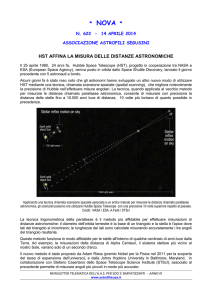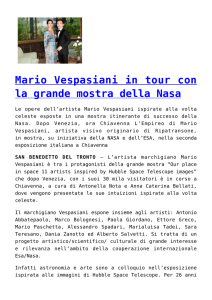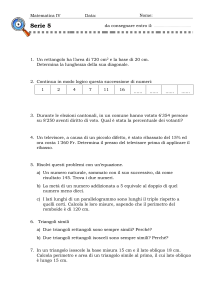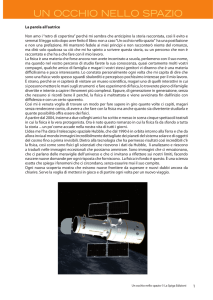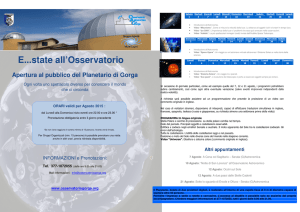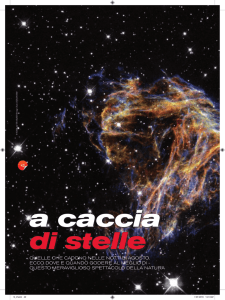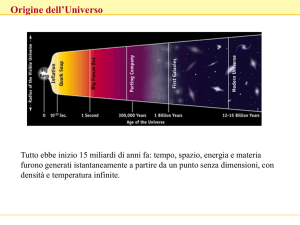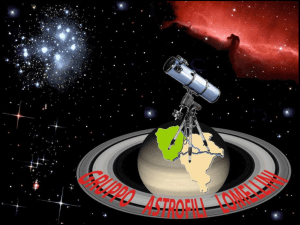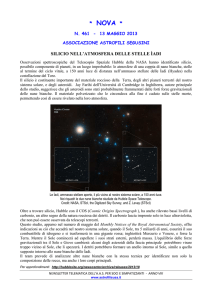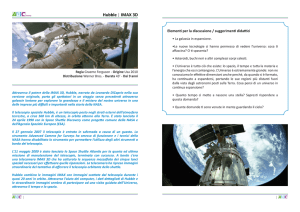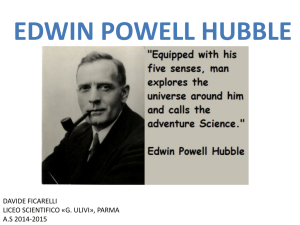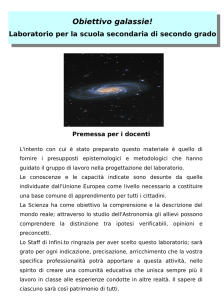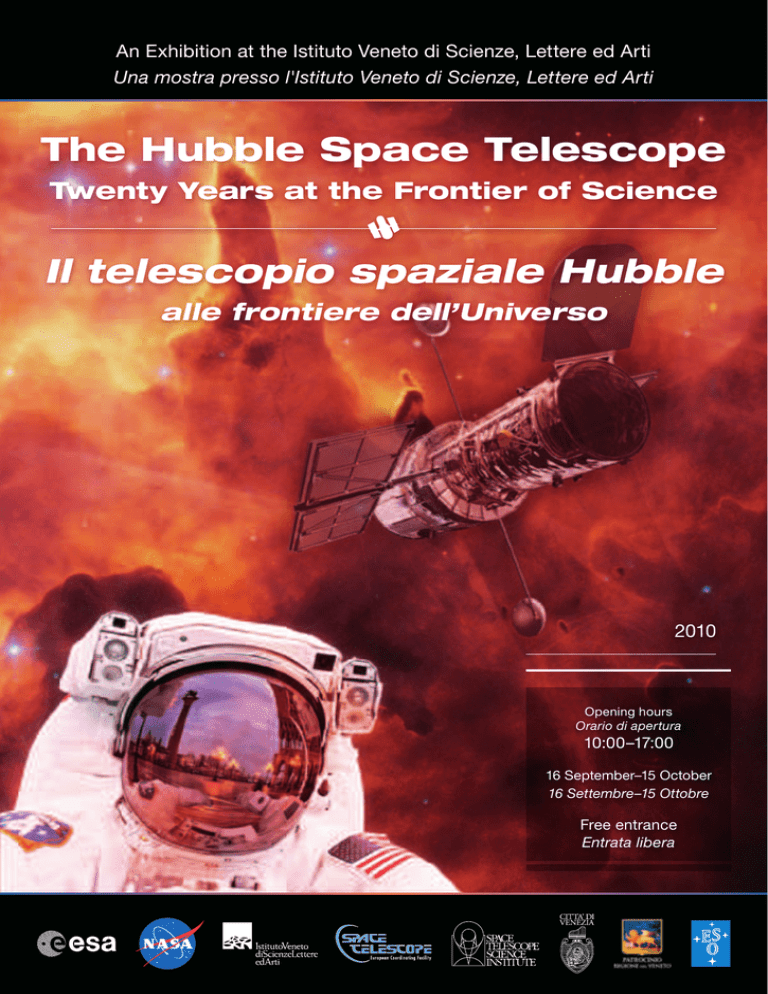
An Exhibition at the Istituto Veneto di Scienze, Lettere ed Arti
Una mostra presso l'Istituto Veneto di Scienze, Lettere ed Arti
The Hubble Space Telescope
Twenty Years at the Frontier of Science
Il telescopio spaziale Hubble
alle frontiere dell’Universo
2010
Opening hours
Orario di apertura
10:00–17:00
16 September–15 October
16 Settembre–15 Ottobre
Free entrance
Entrata libera
Sponsored by:
European Space Agency (ESA),
National Aeronautics and Space
Administration (NASA)
Co-chairs:
Antonella Nota (ESA/STScI) &
Bob Fosbury (ESA/ST-ECF)
Curator:
Mario Livio (STScI)
NASA lead:
Tom Griffin (NASA/GSFC)
Team:
Bonnie Eisenhamer (STScI), Salim
Ansari (ESA), Lars Lindberg
Christensen (ESO), Elena Dalla Bonta
(Padua University), Zolt Levay (STScI),
Mark MacCaughrean (ESA)
Light artist:
Tim Otto Roth
Organisers:
Space Telescope-European Coordinating
Facility (ST-ECF), Space Telescope
Science Institute (STScI), Istituto Veneto
di Scienze, Lettere ed Arti (IVSLA)
Con il patrocinio di:
European Space Agency (ESA) e
National Aeronautics and Space
Administration (NASA)
Curatori:
Antonella Nota (ESA/STScI) e
Bob Fosbury (ESA/ST-ECF)
Direttore artistico:
Mario Livio (STScI)
Responsabile NASA:
Tom Griffin (NASA/GSFC)
Equipe:
Bonnie Eisenhaimer (STScI), Salim
Ansari (ESA), Lars Lindberg
Christensen (ESO), Elena Dalla Bontà
(Università di Padova), Zolt Levay (STScI)
e Mark MacCaughrean (ESA)
Artista:
Tim Otto Roth
Enti organizzatori:
Space Telescope — European
Coordinating Facility (ST-ECF), Space
Telescope Science Institute (STScI) e
Istituto Veneto di Scienze, Lettere ed Arti
(IVSLA)
Istituto Veneto di Scienze,
Lettere ed Arti
Istituto Veneto di Scienze,
Lettere ed Arti
Palazzo Loredan
Campo S. Stefano 2945
30124, Venice
Italy
Opening hours
Orario di apertura
10:00–17:00
16 September–15 October
16 Settembre–15 Ottobre
Free entrance
Entrata libera
Guided tours
Friday and Saturday
(Italian and English)
Visite guidate disponibili in italiano
ed inglese tutti i venerdì e sabato
Credit . Credito: Bob Fosbury
The Hubble Space Telescope:
Twenty Years at the Frontier of Science
This exhibition celebrates the twentieth anniversary of the launch of the Hubble Space Telescope, one of the most ambitious
scientific projects ever undertaken. Named in honour of the famous astronomer Edwin Hubble (1889-1953) — responsible for
the discovery of the expansion of the Universe — the space telescope was the result of close international collaboration between NASA and ESA. Placed in orbit in 1990 by the Space Shuttle Discovery, Hubble is a telescope with a mirror 2.4 metres
in diameter. Hubble’s position above the atmosphere allows it to observe the Universe at wavelengths not accessible from the
surface of our planet, such as the ultraviolet. Its location also places it above the atmospheric turbulence that causes stars to
blur and twinkle when observed from the ground, enabling it to obtain strikingly clear images.
Designed in the seventies, Hubble had very ambitious goals. As the first in a series of Great Observatories in space, Hubble
was built to address the most important questions about the nature of the Universe. As well as achieving its original major
goals, including measuring the expansion rate of the Universe, Hubble has gone on to make major contributions to almost all
topics in astrophysics, from the nature of galaxies at very early epochs to the study of the atmospheres of planets beyond our
Solar System.
Hubble was designed to be maintained, modernised and repaired in orbit. To this end, the spacecraft was constructed to enable astronauts to access and change instruments and systems. It was the first space mission especially designed and built
to be maintained in situ, 575 km from Earth, for at least ten years. Handles placed along the telescope allow astronauts to
grasp the telescope easily. The various instruments are modular, removable and can be located with high precision in the optical system. A system of doors gives astronauts easy access to the interior of the telescope and the instruments it houses.
In all, five shuttle servicing missions have been planned and executed. Each time, the astronauts have removed obsolete or
failed instruments, replaced computers and gyroscopes, and installed new state-of-the-art instruments, leaving the telescope
more powerful and technologically advanced. Measured in terms of sensitivity to faint objects and overall throughput, Hubble
is about a hundred times more powerful now than when it was first launched.
Discoveries made with the Hubble Space Telescope over the last twenty years have profoundly changed our view of the
Universe. Not only is the Universe expanding, its expansion is accelerating. A repulsive force termed dark energy, whose nature is unknown, is responsible for this accelerated motion. Hubble has also made images of planets orbiting nearby stars and
shown that exoplanets have atmospheres whose composition can be measured, identifying constituents such as water and
methane. Hubble has pushed our horizon back to the remote Universe, observing galaxies that were born only 600 million
years after the Big Bang. It has continued to produce stunning images that have become familiar icons of modern life, showing us, through a wealth of detail, that the Universe is exquisitely beautiful, but also extremely complex.
Hubble has not only changed our understanding of the Universe, it has changed the way we do science. It has brought the
Universe into our homes, has inspired and continues to inspire many of us to the extent that it has become “the people’s tele­
scope”. A science whose results were only available to a few has become a resource available to anybody with the interest to
look.
The last servicing mission took place in May 2009. Two new instruments were installed and two
existing instruments, which had recently failed, were repaired during a series of spacewalks of such complexity that it kept astronomers and the public glued to TV
screens. The result is that the Hubble observatory is in its best and most
powerful state ever. The expectation is that Hubble will be able to
work well for at least another seven years as a result of this visit.
The goal of this exhibition is to celebrate the twentieth anniversary of the launch of this historic mission, the constructive cooperation between NASA and ESA on this project, and the remarkable
discoveries that the space telescope has achieved in its two decades of life. The exhibition presents a selection of images obtained
by the space telescope and describes the work of astronauts during
servicing missions. Are included photographs and samples of the
equipment used by astronauts during the most recent Shuttle mission to Hubble.
Il telescopio spaziale Hubble:
alle frontiere dell’Universo
Celebriamo il ventennale del lancio del telescopio spaziale
Hubble, uno dei progetti scientifici più ambiziosi mai realizzati.
Chiamato così in omaggio al famoso astronomo Edwin Hubble
(1889-1953) — scopritore dell’espansione dell’Universo — il
telescopio spaziale è il frutto di una stretta collaborazione internazionale tra la NASA e l’ESA. Messo in orbita nel 1990 da una navetta Shuttle, Hubble è un telescopio con uno specchio di 2,4 metri
di diametro. La sua posizione, al di sopra dell’atmosfera, permette di
osservare l’Universo a lunghezze d’onda non accessibili dalla superficie del nostro
pianeta, come l’ultravioletto. Essa permette inoltre di ottenere immagini di una nitidezza
impressionante, liberandoci dal tipico “scintillio” che le stelle mostrano per effetto della turbolenza atmosferica. Questo fenomeno è ben noto a tutti coloro che contemplano il cielo
stellato in una notte serena e trasparente ed è una severa limitazione alle osservazioni
astronomiche da terra.
Progettato negli anni settanta, Hubble aveva obbiettivi estremamente ambiziosi. Il
primo della serie dei “Grandi Osservatori” spaziali della Nasa, Hubble fu costruito per
capire le leggi dell’espansione dell’Universo, per osservare e studiare le galassie più
lontane, per scoprire la presenza di altri pianeti al di fuori del nostro Sistema Solare.
Fin dall’inizio Hubble fu concepito per essere riparato in orbita. Tutti i sistemi sono accessibili, costruiti con l’idea che, in un
qualche futuro, astronauti avrebbero potuto lavorare su Hubble, cambiando strumenti, riparando guasti e sostituendo componenti. Hubble era la prima missione spaziale ideata e costruita per essere mantenuta in situ, a 575 km dalla superficie terrestre, per almeno dieci anni. Maniglie erano state collocate lungo il telescopio per permettere agli astronauti una presa facile. I
vari strumenti erano modulari ed estraibili. Un sistema di portelloni avrebbe dato agli astronauti facile accesso alle viscere del
telescopio e agli strumenti ivi alloggiati.
Infatti, 5 missioni Shuttle sono state programmate ed eseguite per mantenere ed aggiornare Hubble. Ogni volta gli astronauti
hanno rimosso strumenti obsoleti o guasti, sostituito computer e giroscopi, installato nuovi strumenti, lasciando un telescopio
spaziale nuovo, sempre più potente e tecnologicamente sempre più avanzato.
Le scoperte del telescopio spaziale Hubble hanno profondamente cambiato la nostra visione dell’Universo, che non solo è in
espansione, ma sta addirittura accelerando. Una forza repulsiva di natura ignota, l’energia oscura, è responsabile di questo
moto accelerato. Hubble ha fotografato pianeti orbitanti intorno a stelle vicine ed ha dimostrato che i pianeti extrasolari possono avere un’atmosfera, proprio come la Terra, riconoscendovi elementi noti, come l’acqua e il metano. Hubble ha allargato
la frontiera dell’Universo conosciuto, osservando galassie nate solo 600 milioni di anni dopo il Big Bang. Ha continuato a
produrre immagini stupende che sono diventate parte della nostra vita quotidiana, mostrandoci, con una grande ricchezza di
dettagli, che l’Universo è stupendo ma anche estremamente complesso.
Hubble non ha solamente cambiato la nostra conoscenza dell’Universo. Ha cambiato il modo di fare scienza. Ha portato l’Universo nelle nostre case, ha ispirato e continua a ispirare molti di noi, fino a poterlo definire “il telescopio della gente”, facendo
dell’astronomia, una scienza fino a quel momento riservata a pochi, una risorsa disponibile adesso a tutti, senza distinzione.
Un’ultima missione di manutenzione ha avuto luogo nel maggio del 2009. Alcuni nuovi strumenti sono stati installati e computer obsoleti sono stati sostituiti. Due strumenti, che si erano recentemente guastati, sono stati riparati durante una serie di
passeggiate spaziali di una complessità tale da tenere gli astronomi — e il pubblico — inchiodati agli schermi per cinque interminabili giorni. Il risultato è che Hubble adesso è un osservatorio rinnovato, più potente che mai. Secondo le aspettative, dopo
quest’ultima visita, Hubble sarà in grado di funzionare al meglio per altri sei-sette anni ancora.
L’obbiettivo di questa mostra è celebrare il ventennale del lancio di questa missione storica, la costruttiva collaborazione tra la
NASA e l’ESA a questo progetto e i risultati che il telescopio spaziale ha ottenuto nei suoi vent’anni di vita. La mostra presenta
una selezione di immagini ottenute dal telescopio spaziale e descrive il lavoro degli astronauti durante le missioni di manutenzione. Nella mostra sono inclusi foto e campioni della strumentazione usata dagli astronauti durante l’ultima missione dello
Shuttle al telescopio spaziale.
Credit . Credito: Michael Dawes
Entrance
Entrata
Introduction to the Exhibition
Introduzione alla mostra
Here we present a model of
the Hubble Space Telescope
(scale 1:15) and six panels with
high resolution images taken by
Hubble of galaxies, clusters and
star fields: the Tadpole Galaxy,
the Antennae Galaxies, NGC 602,
the Cone Nebula, Messier 82 and
the star field of the Sagittarius
Window Eclipsing Extrasolar
Planet Search. The images are
compositions of observations at
different wavelengths. The colours
were chosen to provide a realistic
reproduction of the astronomical
objects observed.
In entrata, vengono presentati un
modello del telescopio spaziale
Hubble (in scala 1:15) e sei pannelli
con immagini ad alta risoluzione
di galassie, ammassi e campi
stellari (Girino, Antenne, NGC 602,
Cono, M 82, SWEEPS) prese da
Hubble. Le immagini sono composizioni di osservazioni a diverse
lunghezze d’onda. I colori sono
stati scelti in modo da fornire una
riproduzione realistica degli oggetti astronomici osservati.
Antennae Galaxies
These two spiral galaxies, drawn together by gravity, started to interact a few hundred million years
ago. The Antennae Galaxies are our nearest and the youngest known examples of a pair of colliding
galaxies. They are 62 million light-years away.
Galassie Antenne
Le galassie Antenne sono l’esempio più vicino di galassie “in collisione”. Lo scontro tra queste galassie, attratte dalla loro forza gravitazionale, è iniziato qualche centinaio di milioni di anni fa. Distano da
noi 62 milioni di anni luce.
Credit . Credito
NASA, ESA and the Hubble Heritage Team (STScI/AURA)-ESA/Hubble Collaboration
07
Tadpole Galaxy
The Tadpole is a spiral galaxy in the midst
of a gravitational interaction with the small,
compact blue galaxy visible through the
Tadpole’s disc. Gravitational forces have
pulled a long tail of stars from the galaxy.
This galaxy is 420 million light-years away.
Galassia Girino
Il “Girino” è una galassia a spirale che sta
interagendo con una galassia compatta di
colore blu visibile attraverso il suo disco. La
lunga scia di stelle che si dipana dalla galassia Girino è prodotta dall’azione della gravità
tra le due galassie.
Young star cluster, NGC 602
Bright blue newly formed stars carve a cavity in the centre of this nebula in the Small Magellanic Cloud.
The radiation from the stars shapes the gas and dust. This young star cluster is 200 000 light-years
away.
Ammasso stellare giovane NGC 602
Nel cuore della Piccola Nube di Magellano si fanno spazio brillanti stelle blu, appena nate. La radiazione proveniente da queste stelle scava una vera e propria cavità, dando forma al gas e alla polvere
circostante. Questo giovane ammasso stellare è distante 200 mila anni luce.
Credit . Credito
NASA, ESA and the Hubble Heritage Team (STScI/AURA)-ESA/Hubble Collaboration
Credit . Credito: Bob Fosbury
Credit . Credito
NASA, ESA, H. Ford (JHU), G. Illingworth (UCSC/
LO), M. Clampin (STScI), G. Hartig (STScI), the ACS
Science Team
Entrance
Entrata
Introduction to the Exhibition
Introduzione alla mostra
Star field
Looking toward the crowded centre of
our galaxy, the Milky Way, Hubble studied
180 000 stars and found 16 planet candidates
orbiting a variety of stars. This star field is
26 000 light-years away.
Campo stellare
Guardando in direzione del centro galattico,
Hubble ha osservato 180 mila stelle e trovato
16 possibili pianeti attorno ad alcune di esse.
Questo campo stellare dista 26 mila anni
luce.
Credit . Credito
NASA, ESA, K. Sahu (STScI) and the SWEEPS
Science Team
Cone Nebula
Glowing hydrogen gas produces the red halo of light around this pillar of gas and dust. Stars and planets may eventually form within regions of the Cone Nebula. The Cone Nebula is 2500 light-years away.
Nebulosa Cono
La nebulosa Cono è costituita da una struttura centrale di gas e polvere, circondata da un alone diffuso
di colore rosso, originato dalla forte concentrazione di idrogeno. Questa nebulosa è distante 2500 anni
luce.
Credit . Credito
NASA, ESA, H. Ford (JHU), G. Illingworth (UCSC/LO), M. Clampin (STScI), G. Hartig (STScI), the ACS Science Team
09
Starburst galaxy, M 82
Plumes of glowing hydrogen gas blast
from the central regions of this galaxy.
Young stars are being born in this galaxy
ten times faster than in the Milky Way.
This galaxy is 12 million light-years away.
Galassia attiva M 82
M 82 ha un altissimo tasso di formazione
stellare, pari a dieci volte quello della Via
Lattea. Dal centro della galassia si dispiegano delle caratteristiche strutture di idrogeno, quasi fossero delle piume brillanti.
M 82 è lontana 12 milioni di anni luce.
Credit . Credito
NASA, ESA and the Hubble Heritage Team
(STScI/AURA)
Room . Stanza
LC12
Stars are Born, Live and Die
Le stelle nascono, vivono e muoiono
In this room a series of images
obtained by Hubble are presented, chosen to describe the cycle
of birth, evolution and the final
stages of the life of stars.
It begins with three images of
large fields showing regions of star
formation, the Orion Nebula and
two regions of the Carina Nebula.
These regions are characterised
by high concentrations of dust
and gas, the material from which
the stars form.
In questa stanza vengono presentate una serie di immagini,
ottenute da Hubble, che descrivono il ciclo vitale delle stelle, dalla
nascita fino alle fasi finali della loro
evoluzione.
Si inizia con tre immagini di grandi
campi di formazione stellare: la
nebulosa di Orione, la nebulosa della Carena e la nebulosa
dell’Aquila. Queste regioni si
distinguono per l’alta concentrazione di polvere e gas, il materiale
che poi darà origine alle stelle.
Orion Nebula
More than 3000 stars of various sizes appear in this panoramic image of the Orion Nebula. The pillars
of dense gas may be home to developing stars. This nebula is 1500 light-years away.
Nebulosa di Orione
Più di 3000 stelle fanno capolino nella splendida cornice della nebulosa di Orione. Le colonne di gas
sono regioni di possibile formazione stellare. Questa nebulosa è distante 1500 anni luce.
Credit . Credito
NASA, ESA, M. Robberto (STScI/ESA) and the Hubble Space Telescope Orion Treasury Project Team
011
Carina Nebula
A maelstrom of star birth and death takes
place in this view, 50 light-years across,
of the Carina Nebula, which shows massive stars shredding the giant cloud that
gave them birth. To the left the supermassive star Eta Carinae is nearing the end
of its brief life. This nebula is 8000 lightyears away.
Nebulosa della Carena
In questa regione della nebulosa della
Carena, larga 50 anni luce, si può ammirare la stella supermassiccia Eta Carinae,
che si sta avvicinando alla fine della sua
breve vita. Altre stelle di grande massa,
con i loro potenti venti, distruggono la
nube gigantesca da cui si sono formate.
Questa regione è distante 8000 anni luce.
Credit . Credito
NASA, ESA and the Hubble Heritage Team
(STScI/AURA)
Eagle Nebula
A billowing tower of cold gas and dust rises
from a stellar nursery called the Eagle Nebula.
The ­tower stretches 9.5 light-years, or twice the
distance from our Sun to the nearest star. This
nebula is 6500 light-years away.
Nebulosa dell’Aquila
Un’imponente torre di gas freddo e polveri s’innalza da una regione di formazione stellare chiamata
nebulosa dell’Aquila. La torre ha un’estensione di
9,5 anni luce, pari a due volte la distanza del Sole
dalla stella più vicina. Questa nebulosa è distante
6500 anni luce.
Credit . Credito
NASA, ESA and the Hubble Heritage Team (STScI/AURA)
Room . Stanza
LC12
Stars are Born, Live and Die
Le stelle nascono, vivono e muoiono
Five images of the star V838
Monocerotis, taken months apart,
illustrate the circumstellar environment as a pulse of light from the
star progressively illuminates its
surroundings.
Cinque immagini della stella V838
Monocerotis prese a distanza di
mesi illustrano come un impulso
di luce proveniente dalla stella illumini progressivamente l’ambiente
circostante.
Light echo, V838 Monocerotis
Light echo, V838 Monocerotis
In January 2002, an ordinary star suddenly
brightened 4000 times. Four months later,
light from the flash illuminated this first layer
of previously invisible dust around the star.
This star is 20 000 light-years away.
Light from the star’s initial outburst continued
to travel outwards at 300 000 km/s. Each time
Hubble observed the star, different regions of
dust had become visible.
Eco luminoso di V838 Monocerotis
Nel gennaio 2002, una stella del tutto ordinaria e distante 20 mila anni luce dalla Terra aumenta la sua luminosità di 4000 volte. Quattro
mesi dopo, la luce del lampo iniziale illumina
il primo strato di polvere circumstellare, fino
ad allora invisibile.
Credit . Credito
NASA, ESA, H. E. Bond (STScI) and the Hubble
Heritage Team (STScI/AURA)
Eco luminoso di V838 Monocerotis
La luce del lampo iniziale continua il suo
viaggio nello spazio circostante alla velocità
di 300 mila km/s. Ogni volta che Hubble fotografa questa stella, vengono osservate nuove
regioni di polvere.
Credit . Credito
NASA, ESA, H. E. Bond (STScI) and the Hubble
Heritage Team (STScI/AURA)
013
Light echo, V838 Monocerotis
Three years after the initial flash, the
travelling light continues to reveal new
dust patterns. The illumination gives the
impression that the star itself is changing, when in reality the areas around it are
simply becoming visible.
Eco luminoso di V838
Monocerotis
Tre anni dopo il lampo iniziale, la luce
continua a viaggiare e ad illuminare nuove
regioni. Questa illuminazione progressiva
dà l’impressione che la stella stessa stia
cambiando, mentre è solo un effetto illusorio, provocato dal fatto che nuovi anelli
di polvere diventano visibili.
Credit . Credito
NASA, ESA, H. E. Bond (STScI) and the Hubble
Heritage Team (STScI/AURA)
Light echo, V838 Monocerotis
Light echo, V838 Monocerotis
This progressive illumination of shells of dust
around the star is called a “light echo”. In
this image, approximately eight months have
passed since the initial flash.
The star’s outburst is not fully understood
and may be a transitory stage in stellar evolution that is rarely seen. The dust in these
surrounding regions was presumably ejected
during previous outbursts.
Eco luminoso di V838 Monocerotis
Tutt’intorno alla stella s’illuminano in progressione una serie di archi formati dalla polvere,
quasi in una sorta di “eco luminoso”. Questa
immagine è stata catturata circa otto mesi
dopo il lampo iniziale.
Credit . Credito
NASA, ESA, H. E. Bond (STScI) and the Hubble
Heritage Team (STScI/AURA)
Eco luminoso di V838 Monocerotis
Il meccanismo che ha provocato il lampo
iniziale non è del tutto noto. È possibile che si
tratti di uno stato transitorio raramente osservato nell’evoluzione della stella. È comunque
probabile che la polvere presente nelle regioni circostanti sia stata emessa dalla stella
stessa durante fasi evolutive precedenti.
Credit . Credito
NASA, ESA and the Hubble Heritage Team (STScI/
AURA)
Room . Stanza
LC18
Stars in Formation and Planets
Stelle in formazione e pianeti
Three light panels show three
other fields of star formation: The
Tarantula Nebula, NGC 346 and
a field in Carina. The Tarantula
Nebula is the most massive
star-forming region in the Large
Magellanic Cloud. NGC 346
is its counterpart in the Small
Magellanic Cloud. Both images
show thousands of stars that were
born only a few million years ago.
Two panels show images of two
bright planets in our Solar System,
observed by Hubble in visible light.
Tre pannelli luminosi mostrano
altre tre regioni di cielo in cui
si formano stelle: 30 Doradus,
NGC 346 e una regione della
Carena. 30 Doradus è la regione di formazione stellare più
massiccia nella Grande Nube di
Magellano. NGC 346 è invece la
controparte nella Piccola Nube
di Magellano. Entrambe le immagini mostrano migliaia di stelle
nate pochi milioni di anni fa.
Due pannelli luminosi mostrano
le immagini di due pianeti appartenenti al nostro Sistema Solare:
Giove e Saturno, osservati da
Hubble nella luce visibile.
Star cluster in the large
star-forming Tarantula Nebula
Infant stars in the small Magellanic
Cloud, NGC 346
Brilliant blue stars are wreathed in glowing
clouds in the largest stellar nursery in the
Large Magellanic Cloud. Many of the stars
are among the most massive known. This star
cluster is 170 000 light-years away.
This nearby region of 70 000 stars contains a
number of embryonic stars. The smallest of
these newly forming stars is half the mass of
the Sun. This star-forming region is 210 000
light-years away.
Ammasso stellare 30 Doradus
Stelle appena nate nella Piccola
Nube di Magellano: NGC 346
Giovani e brillanti stelle blu formano una
ghirlanda luminosa nella più grande regione
di formazione stellare della Grande Nube di
Magellano. Molte di queste stelle sono tra le
più massicce conosciute. Quest’ammasso è
distante 170 mila anni luce.
Credit . Credito
NASA, ESA, F. Paresce (INAF-IASF, Bologna, Italy),
R. O'Connell (University of Virginia, Charlottesville)
and the Wide Field Camera 3 Science Oversight
Committee
Questa regione contiene 70 mila stelle, molte
delle quali ancora in una fase embrionale. La
più piccola stella osservata ha una massa pari
a metà di quella del Sole. Questa regione è
distante 210 mila anni luce.
Credit . Credito
NASA, ESA, and A. Nota (STScI/ESA)
015
The Carina Nebula’s Mystic
Mountain
Mountains of dust and gas rise in the
Carina Nebula. Stars within the pillars
unleash jets of gas that stream from the
peaks. This nebula is 7500 light-years
away.
Montagna Mistica nella
nebulosa della Carena
Montagne di polveri e gas si elevano al
centro della nebulosa nella costellazione
della Carena. Dalle sommità di queste
montagne sgorgano i getti di gas prodotti
dalle stelle che si trovano al loro interno.
Questa nebulosa è distante 7500 anni
luce.
Credit . Credito
NASA, ESA, M. Livio and the Hubble 20th
Anniversary Team (STScI)
Asteroid collides with Jupiter
Quadruple Saturn moon transit
The dark smudge at Jupiter’s bottom right in
this image is debris from a possible rogue asteroid that plunged into the gas giant planet
in July 2009. Engineers interrupted Hubble’s
calibration following its servicing mission to
take the picture. Jupiter is 780 million kilometres away.
The giant moon Titan casts a large shadow
near Saturn’s north pole, while Mimas casts
a smaller shadow nearer the equator. Further
to the left are the bright moon Dione and the
fainter Enceladus. Saturn is 1.4 billion kilo­
metres away.
Asteroide in collisione con Giove
La macchia scura nella parte inferiore di
questa immagine del pianeta Giove è stata
causata da una collisione con un asteroide,
che è precipitato sul pianeta gassoso nel
luglio 2009. Per riuscire a scattare questa
fotografia, gli ingegneri hanno sospeso le
attività di controllo programmate dopo la fine
dell’ultima missione di manutenzione. Giove è
distante 780 milioni di chilometri.
Credit . Credito
NASA, ESA, M. H. Wong (University of California,
Berkeley), H. B. Hammel (Space Science Institute,
Boulder, Colo.), I. de Pater (University of California,
Berkeley) and the Jupiter Impact Team
Quadruplo transito su Saturno
La gigantesca luna Titano proietta la sua
ombra vicino al polo nord di Saturno, mentre
la piccola ombra di Mimas è visibile vicino
all’equatore del pianeta. A sinistra si vedono altre due lune: Dione, più brillante, ed
Encelado, più debole. Saturno è distante
1.4 miliardi di chilometri.
Credit . Credito
NASA, ESA and the Hubble Heritage Team (STScI/
AURA)
Room . Stanza
LC20
The Death of Stars
La morte delle stelle
The death of stars is a spectacular phenomenon. Huge amounts
of material are ejected from the
star in the final stages, creating
extraordinary objects called planetary nebulae. In extreme cases
the star becomes a supernova.
The remains of the supernova explosion, which almost completely
destroys the star, stay visible for
centuries. Light panels and prints
show four examples of planetary
nebulae, the Helix Nebula, the
Cat’s Eye Nebula, the Bug Nebula,
and the Eskimo Nebula, and two
supernova remnants, Cassiopeia
A and the Crab Nebula.
La morte delle stelle è un fenomeno spettacolare. Enormi quantità
di materia sono espulse dalla stella nelle fasi finali, creando oggetti
straordinari chiamati nebulose
planetarie. Nei casi più estremi
la stella diventa una supernova.
I resti dell’esplosione, che distrugge quasi completamente la
stella, rimangono visibili per secoli.
Quattro esempi di nebulose planetarie sono mostrate in stampe e
pannelli luminosi: Elica, Occhio di
Gatto, Farfalla, Eschimese e due
resti di supernova, Cassiopea A e
nebulosa del Granchio.
Helix Nebula
This doughnut-shaped planetary nebula
is actually a vast tunnel of glowing gas. In
the nebula’s centre glows a small, superhot white dwarf — the remains of the star
that created the Helix. This nebula is 650
light-years away.
Nebulosa Elica
Questa nebulosa dalla forma di un anello
è in realtà un largo tunnel di gas illuminato. Al centro del tunnel, si può vedere la
stella che ha originato la nebulosa: una
caldissima nana bianca distante 650 anni
luce.
Credit . Credito
NASA, ESA, C.R. O'Dell (Vanderbilt University),
M. Meixner and P. McCullough (STScI)
Bug Nebula
Eskimo Nebula
Roiling cauldrons of gas heated to more
than 20 000 degrees Celsius form a delicate
­butterfly shape in this planetary nebula,
which has a classic hourglass shape imposed
by its thick central dust belt. This planetary
nebula is 3800 light-years away.
This planetary nebula, the remains of a dying
star, was first observed in 1787. The nebula is
composed of two elliptically shaped lobes of
matter, streaming from above and below the
star. This planetary nebula is 5000 light-years
away.
Nebulosa Farfalla
Nebulosa Eschimese
Vortici di gas ad altissima temperatura (circa
20 mila °C) disegnano una sorta di leggiadra
farfalla in questa nebulosa planetaria. La
tipica forma a clessidra della nebulosa è conseguenza dello spessore del disco che circondava la stella. Questa nebulosa planetaria
è distante 3800 anni luce.
Questa nebulosa planetaria, che mostra le
spoglie di una stella morente, fu osservata
per la prima volta nel 1787. La nebulosa è
composta di due lobi di materia di forma
ellittica espulsi dai poli della stella. È ad una
distanza di 5000 anni luce.
Credit . Credito
NASA, ESA and the Hubble SM4 ERO Team
Credit . Credito
NASA, ESA, A. Fruchter, and the ERO Team [S.
Baggett (STScI), R. Hook (ST-ECF), Z. Levay (STScI)]
017
Cassiopea A:
Supernova remnant
These colourful streamers are the remains of
a massive star that died in a supernova explosion. They comprise the youngest known
super­nova remnant in the Milky Way. This
super­nova remnant is 10 000 light-years away.
Cassiopea A:
un resto di supernova
Questi festoni colorati sono i resti di una stella massiccia esplosa come una supernova,
la più giovane supernova della Via Lattea. Si
trova ad una distanza di 10 mila anni luce.
Credit . Credito
NASA, ESA and the Hubble Heritage (STScI/AURA)ESA/Hubble Collaboration
Cat’s Eye Nebula
Crab Nebula
This planetary nebula has one of the most
complex forms known for this kind of nebula,
consisting of 11 shells of gas. The shells
form a layered, onion-skin structure around
the dying star. This planetary nebula is 3000
light-years away.
Observers recorded the explosion that created this supernova remnant in 1054. Today all
that remains are these expanding filaments
around a rapidly spinning neutron star. This
supernova remnant is 6500 light-years away.
Nebulosa Occhio di Gatto
Questa nebulosa planetaria, che si trova ad
una distanza di 3000 anni luce, ha una morfologia complessa con ben 11 gusci concentrici
di gas. I gusci formano una struttura “a cipolla” attorno alla stella morente.
Credit . Credito
NASA, ESA, HEIC and the Hubble Heritage Team
(STScI/AURA)
Nebulosa del Granchio:
un resto di supernova
L’esplosione che ha originato questo resto di
supernova fu osservata nel 1054. Oggi, tutto
quello che rimane è una miriade di filamenti
di gas che si espande allontanandosi da una
stella a neutroni. Questo resto di supernova è
ad una distanza di 6500 anni luce.
Credit . Credito
NASA, ESA and J. Hester (Arizona State University)
Room . Stanza
LC22
From Stars to Galaxies
Dalle stelle alle galassie
We move away from our Solar
System on a trip to the borders of
the Universe. There are two images and three panels of bright
nearby galaxies: NGC 1300, the
Sombrero Galaxy and Stephan’s
Quintet, Messier 101 and
NGC 3370. Observe the different
patterns: the spiral structure of
Messier 101 is very similar to the
Milky Way, and very different from
the elliptical galaxy at the bottom
right of Stephan’s Quintet.
Ci si allontana dal nostro Sistema
Solare in un viaggio verso i
confini dell’Universo. Vengono
presentate due immagini e tre
pannelli ­luminosi di galassie vicine:
NGC 1300, la galassia Sombrero
e il quintetto di Stephan,
Messier 101, NGC 3370. Si riconoscono morfologie diverse, dalla
struttura a spirale di Messier 101
molto simile alla Via Lattea, a quella ellittica in basso a destra del
quintetto di Stephan. (NGC 3370
e’ una galassia a spirale).
Interacting galaxies:
Stephan’s Quintet
Three of the five galaxies in this famous galaxy quintet appear to be interacting. Their
distorted shapes, elongated spiral arms and
long tidal tails are evidence of their encounters. Four galaxies are 290 million light-years
away. The large, bluer galaxy is 40 million
light-years away.
Quintetto di Stephan: un gruppo
di galassie interagenti
Tre galassie di questo quintetto stanno interagendo tra loro come risulta dalla morfologia
distorta dei loro bracci di spirale allungati.
Quattro galassie sono lontane 290 milioni di
anni luce. La quinta, più grande e più blu, è
più vicina e si trova a soli 40 milioni di anni
luce.
Credit . Credito
NASA, ESA and the Hubble SM4 ERO Team
Pinwheel Galaxy, Messier 101
The Pinwheel Galaxy shows off its magnificent spiral structure. Bright blue clumps are
regions of new stars, while the yellowish core
consists mainly of old stars. This galaxy is
25 million light-years away.
Galassia Girandola Messier 101
La galassia Girandola è un esempio spettacolare di galassia a spirale. Le regioni compatte
blu sono zone di formazione stellare, mentre il
centro — di colore rosa pallido — è costituito
da stelle vecchie. Questa galassia è a 25 milioni di anni luce di distanza.
Credit . Credito
NASA, ESA, K. Kuntz (JHU), F. Bresolin (University
of Hawaii), J. Trauger (Jet Propulsion Lab), J. Mould
(NOAO), Y.-H. Chu (University of Illinois, Urbana)
and STScI
019
Sombrero Galaxy
A brilliant white core is encircled by thick
dust lanes in this spiral galaxy, seen
nearly edge-on. The galaxy is 50 000
light-years across and 28 million lightyears from Earth.
Galassia Sombrero
Il bianco nucleo brillante di questa galassia a spirale è avvolto da uno spesso
disco, visto di taglio. La galassia è larga
50 mila anni luce e dista 28 milioni di anni
luce.
Credit . Credito
NASA, ESA and the Hubble Heritage Team
(STScI/AURA)
Spiral galaxy, NGC 3370
Barred spiral galaxy, NGC 1300
Amid a backdrop of far-off galaxies, this
majestic dusty spiral galaxy looms in the
foreground of this image. Hotbeds of new
star formation can be seen in the intricate
spiral arm structure. This galaxy is 98 million
light-years away.
This barred spiral galaxy, in which the spiral
arms are connected by a bar of stars, contains an inner disc with another spiral at its
centre. Only galaxies with large-scale bars
seem to have these inner discs. This galaxy is
69 million light-years away.
Galassia a spirale NGC 3370
Galassia a spirale barrata
NGC 1300
Questa maestosa galassia a spirale è proiettata su uno sfondo denso di galassie lontane.
Sono visibili regioni compatte di formazione
stellare, blu e brillanti, incastonate nella complessa struttura dei bracci di spirale. Questa
galassia è distante 98 milioni di anni luce.
Credit . Credito
NASA, ESA, the Hubble Heritage Team and A. Riess
(STScI).
In questa galassia a spirale, i bracci sono
collegati da una struttura allungata di stelle
detta barra. Al centro è visibile un disco con
un’ulteriore struttura a spirale. Solo galassie
con grandi barre sembrano possedere questi
dischi centrali. Questa galassia è a una distanza di 69 milioni di anni luce.
Credit . Credito
NASA, ESA and the Hubble Heritage Team (STScI/
AURA)
Room . Stanza
LC24
The Machine: The Hubble Space Telescope
La macchina: il telescopio spaziale Hubble
A large print of the Hubble Space
Telescope in orbit provides a
reference for the components presented in this room and the next.
There is a large section of a solar
panel flown with Hubble at the
beginning of the mission. Marks
caused by the impacts of micrometeorites encountered in orbit
can be seen on the panel’s surface. A high definition television
screen shows sequences of the
Shuttle servicing mission undertaken in May 2009.
Una grande fotografia del telescopio spaziale Hubble in orbita provvede un riferimento ai dettagli tecnici presentati in questa stanza e
quella successiva. Viene esposto
un grande frammento di pannello
solare montato su Hubble all’inizio
della missione. Sulla superficie
del pannello è visibile l’impatto di
micrometeoriti incontrati durante la
permanenza in orbita. Una televisione ad alta risoluzione presenta
sequenze della missione dello
Shuttle eseguita nel maggio 2009.
Solar array
Section from ESA’s second set of solar panels powering the Hubble Space Telescope from December
1993 until March 2002. The two solar array wings, carrying 48 760 silicon solar cells (each 2 cm x 4 cm)
and generating 5000 Watts of power, were brought back to Earth by the Space Shuttle Columbia for an
intensive post-flight investigation.
Pannello solare
Sezione appartenente alla seconda generazione di pannelli solari costruiti dall’ESA e usati per dare
energia ad Hubble dal dicembre 1993 al maggio 2002. I due pannelli solari, che contengono 48760
celle solari e generano 5 KW di energia, sono stati riportati a Terra dalla navetta spaziale Columbia per
essere studiati dopo la loro lunga permanenza nello spazio.
Credit . Credito
ESA
021
The Hubble Space Telescope
Hubble drifts over Earth after its release
on 19 May 2009 by the crew of the Space
Shuttle Atlantis. The crew had performed
all planned tasks over the course of five
spacewalks, making Servicing Mission
4, the fifth astronaut visit to the Hubble
Space Telescope, an unqualified success.
Il Telescopio Spaziale Hubble
Questa immagine di Hubble è stata scattata dallo Shuttle, dopo che il telescopio
è stato rilasciato nello spazio dall’equipaggio della navetta spaziale Atlantis
nel maggio 2009. Sullo sfondo si vede la
Terra. Nel corso di cinque passeggiate
nello spazio, gli astronauti hanno completato con successo un programma
estremamente ambizioso di riparazione e
istallazione di nuova strumentazione.
Credit . Credito
NASA & ESA
Room . Stanza
LC21
Tools
Gli strumenti
Wire cutter
ACS card extraction tool
Lubricant applicator
Astronauts used this tool during Servicing
Mission 4 to cut through the small wires that
attached protective insulation blankets onto
Hubble’s panels.
The repairs to Hubble’s Advanced Camera
for Surveys involved electronics cards too
sharp to handle safely in spacesuits. This tool
allowed the astronauts to remove the cards
without touching them.
Hubble’s door bolts were loosened with the
help of this tool. Astronauts applied a thin
layer of grease to ease fastener actuation.
Pinza tagliafili
Gli astronauti hanno usato un modello di questa pinza durante la missione SM4 per tagliare i fili che collegano l’isolamento protettivo ai
pannelli di Hubble.
Credit . Credito
M. Soluri and NASA
Applicatore di lubrificante
Dispositivo per l’estrazione della
Advanced Camera for Surveys
La riparazione dello strumento di osservazione Advanced Camera for Surveys richiedeva
la sostituzione di schede troppo taglienti
per essere toccate con i guanti delle tute da
astronauta. Questo dispositivo ha permesso
agli astronauti di estrarre le schede senza
toccarle direttamente.
Credit . Credito
M. Soluri and NASA
In this room we show examples of
the tools used by the astronauts in
the last servicing mission. Six light
panels illustrate a selection of the
tools, imaged at high resolution.
In questa stanza vengono presentati modelli di alcuni degli strumenti
usati dagli astronauti nell’ultima
missione di manutenzione, SM4
(Servicing Mission 4). Sei pannelli
luminosi illustrano una selezione di
strumenti ad alta risoluzione.
Le viti dei portelloni di Hubble sono state
allentate con l’aiuto di questo strumento. Gli
astronauti hanno applicato piccole dosi di
lubrificante per facilitare la manipolazione
delle viti.
Credit . Credito
M. Soluri and NASA
023
Mini power tool and holster
Vent plugs and caddy
Capture tool, #10 torque set
The mini power tool and holster is a batterypowered, high-speed device that used screw
bits to remove fasteners on the Advanced
Camera for Surveys and the Space Telescope
Imaging Spectrograph.
Hubble’s deteriorating insulating blankets
were replaced with new, protective panels.
Vent plugs slid easily into holes to hold the
new panels in place.
Time is precious during extravehicular activities. This spring-loaded, #10 torque-set drive
tool captured and removed both fasteners
and washers safely and easily.
Valvole di depressurizzazione
Dispositivo di ancoraggio e chiave
dinamometrica
Mini attrezzo elettrico
Il mini attrezzo elettrico è un cacciavite ad
alta velocità, alimentato da una pila, che è
stato usato per rimuovere viti sugli strumenti Advanced Camera for Surveys e Space
Telescope Imaging Spectrograph.
Credit . Credito
M. Soluri and NASA
Il rivestimento isolante di Hubble si è deteriorato con la permanenza in orbita ed è stato
parzialmente sostituito durante la missione
SM4. I nuovi pannelli isolanti sono stati fissati
in loco con questi particolari “tappi”.
Credit . Credito
M. Soluri and NASA
Il tempo è prezioso durante le missioni di manutenzione. Questo set dinamometrico #10
con valvole pre-caricate ha fissato e rimosso
in sicurezza e con facilità viti e rondelle.
Credit . Credito
M. Soluri and NASA
Room . Stanza
LC19
At the Edge of the Universe
Ai limiti dell’Universo
In this room you see pictures of
some of the most distant objects
observed by Hubble. The larger
print is an image of the Hubble
Ultra Deep Field, the deepest image ever obtained in visible light
through a telescope. Two panels
show bright clusters of galaxies, Abell 370 and ESO 325. Also
shown is a pair of interacting galaxies, NGC 5257.
In questa stanza vengono presentate immagini degli oggetti più
lontani osservati da Hubble.
Viene mostrata una foto dell’
“Hubble Ultra Deep Field, l’immagine più profonda mai ottenuta,
nel visibile, da un telescopio.
Due pannelli luminosi mostrano gli
ammassi di galassie Abell 370 e
ESO 325. Un terzo pannello luminoso mostra una coppia di galassie interagenti.
Gravitational lensing in galaxy
cluster, Abell 370
The immense gravity of this galaxy cluster
warps and magnifies the light of far distant
galaxies behind it. The arcs and streaks in the
picture are stretched images of those faraway
galaxies. This galaxy cluster is five billion
light-years away.
Cluster of galaxies, ESO 325
A massive elliptical galaxy, the glowing
sphere near the centre of this image, dominates this cluster of galaxies. Other ellipticals and several spiral galaxies are obvious
nearby. This cluster of galaxies is 450 million
light-years away.
Ammasso di galassie ESO 325
Lente gravitazionale nell’ammasso
di galassie Abell 370
L’immensa forza gravitazionale in questo
ammasso di galassie distorce ed ingrandisce
l’immagine di galassie lontane che si trovano
dietro l’ammasso. Gli archi nella foto sono
immagini allungate delle galassie lontane.
Questo ammasso di galassie è a 5 miliardi di
anni luce di distanza.
Credit . Credito
NASA, ESA, the Hubble SM4 ERO Team and the
ST-ECF
L’oggetto brillante al centro dell’immagine è
una galassia ellittica massiccia che domina
questo ammasso di galassie a 450 milioni di
anni luce di distanza. Altre galassie ellittiche e
a spirale sono visibili in vicinanza.
Credit . Credito
NASA, ESA and the Hubble Heritage Team (STScI/
AURA)
025
Pair of colliding galaxies,
NGC 5257 and NGC 5258
This galaxy pair is interacting gravitationally, connected by a dim bar of stars like
two dancers holding hands. Both galaxies
harbour black holes in their centres and
are forming stars in their discs. These galaxies are 300 million light-years away.
Coppia di galassie in collisione:
NGC 5257 e NGC 5258
Queste due galassie sono ad una distanza
di 300 milioni di anni luce e stanno interagendo gravitazionalmente. Sono connesse da una debole barra di stelle quasi
come fossero due ballerini che si tengono
per mano. Entrambe ospitano un buco
nero al proprio centro e formano nuove
stelle nel proprio disco.
Credit . Credito
NASA, ESA, the Hubble Heritage (STScI/
AURA)-ESA/Hubble Collaboration, and A. Evans
(University of Virginia, Charlottesville/NRAO/
Stony Brook University)
Hubble Ultra Deep Field
Hubble peers back through space to see galaxies that existed 13 billion years ago, just 600-800 million
years after the Big Bang. These early galaxies are the building blocks that gave rise to the mature galaxies we see today. They are 13 billion light-years away.
Hubble Ultra Deep Field
Questa è la più profonda immagine dell’Universo, in cui le galassie ci appaiono com’erano 13 miliardi
di anni fa, cioè 600 milioni di anni dopo il Big Bang. Questi oggetti primordiali sono i “mattoni” dalla cui
fusione si sono formate le galassie così come le osserviamo oggi.
Credit . Credito
NASA, ESA, S. Beckwith (STScI) and the HUDF Team
Palazzo Franchetti Facade
Facciata di Palazzo Franchetti
For the period of the exhibition, the
exterior of the Palazzo Franchetti will
be illuminated using a scanning green
laser and an image projector to show
signals “from the distant past” originating from the primordial Universe.
The installation, by the German artist
Tim Otto Roth, will be located beside
the Academia Bridge over the Grand
Canal. During every evening of the
exhibition, it will project spectra (the
distribution of brightness with colour) and the corresponding images
of some of the most distant galaxies ever observed in the Universe,
obtained with one of the principal
instruments on Hubble.
While these will appear abstract to
the casual viewer, the interested
­audience will be led to an explanation
found within the Loredan exhibition.
Never seen in public before, these
data represent the very limits of our
knowledge of the distant Universe
today.
Durante la mostra, la facciata di
Palazzo Franchetti sarà illuminata da
una luce laser verde che illustrerà,
in modo astratto, le informazioni che
Hubble ha raccolto dall’universo primordiale.
Queste proiezioni, ideate e realizzate
dall’artista Tedesco Tim Otto Roth,
saranno effettuate tutte le sere e
saranno ben visibili dal Ponte dell’Accademia e dal Canal Grande. Dal
tramonto, per un paio d’ore, verranno
proiettati sulla facciata gli spettri (i segnali luminosi decomposti nelle varie
lunghezze d’onda) di galassie lontane, raccolte da uno degli strumenti
installati su Hubble, la Advanced
Camera for Surveys. In parallelo,
immagini stilizzate delle galassie più
lontane verranno proiettate sul prato.
Per il pubblico interessato, una spiegazione della rappresentazione verrà
fornita nell’ultima sala della mostra
a Palazzo Loredan. Questi dati, mostrati a Venezia in anteprima assoluta,
rappresentano i confini estremi della
nostra conoscenza dell’Universo
lontano.
From the Distant Past
Segnali dall’Universo primordiale
027
Laser projected spectrum
A scanning laser projector draws the
spectrum of a very distant galaxy onto the
facade of the Palazzo Franchetti, visible
from the Grand Canal and the Academia
Bridge.
Spettro astronomico
proiettato sulla facciata di
Palazzo Franchetti
Un proiettore laser disegna, sulla facciata
di palazzo Franchetti, lo spettro di una galassia lontana. La proiezione è visibile dal
Ponte dell’Accademia e dal Canal Grande.
Credit . Credito
Istituto Veneto, Tim Otto Roth & Bob Fosbury
(ESA/ST-ECF)
From the distant past
Image of a distant galaxy
Data from some of the most distant objects,
including galaxies and quasars, are being projected onto the Palazzo Franchetti.
These objects appear as they were when
the Universe was less than a tenth of its current age. The data were obtained with one
of the Hubble cameras fitted with a device
that spreads the light into a band of colours.
These spectra can be used to measure the
distances and ages of many of the very faint
objects that appear in Hubble images.
A “pixellated” image of the galaxy whose
spectrum is drawn on the Franchetti facade is
projected onto the lawn of the Palazzo.
Segnali dall’Universo primordiale
Credit . Credito
Tim Otto Roth & Bob Fosbury (ESA/ST-ECF)
Sulla facciata di Palazzo Franchetti saranno
proiettate le informazioni riguardanti alcuni
degli oggetti astronomici più distanti osservati dal telescopio Hubble. Questi oggetti,
tra cui galassie lontane e quasar, ci appaiono
com’erano quando l’età dell’Universo era un
decimo di quella attuale. Hubble è dotato
di strumenti in grado di scomporre la luce
proveniente dagli oggetti astronomici nei vari
colori, creando quello che viene chiamato
“spettro”, da cui si misurano la distanza e
l’età degli oggetti in questione.
Credit . Credito
NASA, ESA, the Hubble SM4 ERO Team and the
ST-ECF
Credit . Credito: Bob Fosbury
Un’imaggine a pixel di una
galassia distante
Un’immagine a pixel della galassia il cui
spettro è disegnato sulla facciata di palazzo
Franchetti è proiettata sul prato del palazzo.
At the time of this exhibition, the Hubble Space Telescope will have completed more than 111 000
orbits of the Earth. During Hubble’s 20 years of operation, astronomers using its instruments have
transformed our view of the Universe and changed the way science has been brought into people’s
homes — represented by the universally recognised and stunningly beautiful images. From studies of
objects in the most distant reaches of space and time to the analysis of planetary atmospheres both
within and outside our Solar System, Hubble has influenced almost every part of astrophysics. In these
rooms, you will see some of the most striking images and discover how the astronauts were able to
perform their complex tasks in space to keep the observatory operating at peak performance.
Quando si terrà questa mostra, il Telescopio Spaziale Hubble avrà effettuato più di 111’000 orbite intorno alla Terra. Durante i venti anni di attività del telescopio, gli astronomi, usando i differenti strumenti
a bordo, hanno trasformato la nostra visione dell’Universo e hanno cambiato il modo in cui la scienza
— rappresentata dalle splendide immagini fornite da Hubble — è stata portata nelle case della gente.
Il telescopio spaziale ha influenzato quasi ogni settore dell’astrofisica, dall’analisi di atmosfere planetarie nel nostro Sistema Solare ed in altri sistemi stellari, fino allo studio di oggetti nelle regioni più remote
dello spazio e del tempo. In queste stanze potrete ammirare alcune delle più spettacolari immagini e
scoprire come gli astronauti siano stati in grado di eseguire nello spazio le complesse operazioni necessarie per far funzionare al meglio il telescopio.
Credit . Credito: Bob Fosbury
This exhibit would never have seen the light of day without the tireless contributions of many people. We are very grateful to:
Lucy Albert (STScI), Greg Bacon (STScI), Tracy Bennett (STScI), Francesco Bertola (U. Padova), Justin Cassidy (GSFC/LM),
Mary Cesetti (U. Padova), Karen Debelius (STScI), Lothar Gerlach (ESA), John Godfrey (STScI), Remy van Haarlem (ESA),
Maurice Henderson(GSFC), Hännes Heyer (ESO), Mary Humphreys (GSFC/SGT), Edmund Janssen (ESO), Jim Jeletic (GSFC),
Ashley Knight (GSFC/OSC), Marco Lombardi (ST-ECF), Patricia Manalansan (GSFC/ASRC), Jean Manall (GSFC), Giovanna
Palandri (IVSLA), Arvind Parmar (ESA), Elisa Portaluri (U. Padova), Alvio Renzini (INAF), André Roquette (ESO), Carolyn
Slivinski (STScI), Benjamin Staude (Bernstein Center Freiburg), Rolanda Taylor (STScI), Francesco Toaldo (IVSLA) and Donna
Weaver (STScI). Special thanks go to Mafalda Martins and Luis Calçada (ESO) for the beautiful poster graphics and to Pam
Jeffries (STScI) for the design of the explanatory cards. Without John Grunsfeld, none of this would have happened. We are
most grateful to the IVSLA for hosting this Hubble exhibition in their magnificent home.
Questa mostra è stata realizzata solo grazie alla partecipazione di molte persone. Ringraziamo di cuore: Lucy Albert
(STScI), Greg Bacon (STScI), Tracy Bennett (STScI), Francesco Bertola (U. Padova), Justin Cassidy (GSFC/LM), Mary
Cesetti (U. Padova), Karen Debelius (STScI), Lothar Gerlach (ESA), John Godfrey (STScI), Remy van Haarlem (ESA), Maurice
Henderson(GSFC), Hännes Heyer (ESO), Mary Humphreys (GSFC/SGT), Edmund Janssen (ESO), Jim Jeletic (GSFC), Ashley
Knight (GSFC/OSC), Marco Lombardi (ST-ECF), Patricia Manalansan (GSFC/ASRC), Jean Manall (GSFC), Giovanna Palandri
(IVSLA), Arvind Parmar (ESA), Elisa Portaluri (U. Padova), Alvio Renzini (INAF), André Roquette (ESO), Carolyn Slivinski
(STScI), Benjamin Staude (Bernstein Center Freiburg), Rolanda Taylor (STScI), Francesco Toaldo (IVSLA), Donna Weaver
(STScI). Un ringraziamento speciale a Mafalda Martins e Luis Calçada (ESO) per la grafica spettacolare e Pam Jeffries (STScI)
per la produzione delle schede descrittive. Senza John Grunsfeld nulla di tutto questo si sarebbe realizzato. Siamo estremamente grati all’ Istituto Veneto di Scienze, Lettere ed Arti per avere ospitato “Hubble” nella loro magnifica sede.

